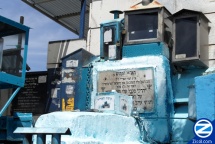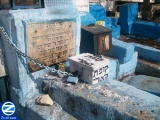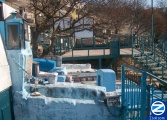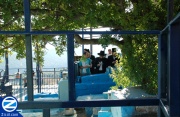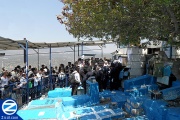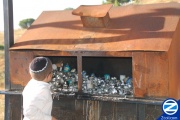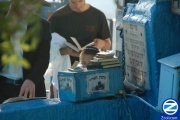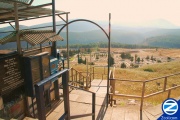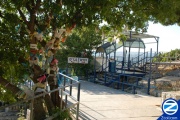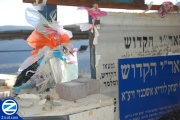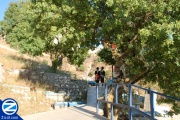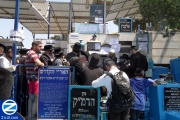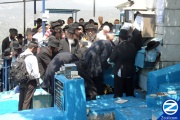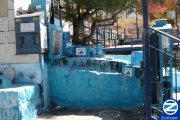Rabbi Yitzchak Luria
Rabbi Yitzchak Luria, also known as the Ari Hakadosh (the Holy and G-dly Rabbi Yitzchak) and the Arizal was one of the leading Kabbalists to ever live. According to Breslov tradition, he was one of the 5 Tzadikai Yesod Olam throughout history. Born in Yerushalaim, the Ari moved to Egypt at a young age, where through tremendous self effort, prayers, meditations and seclusion he managed to reach tremendous spiritual heights. At age 35, the Ari moved to Tzfat, becoming its leading Kabbalist after the passing of the Ramak. Despite the short amount of time he lived in Tzfat before passing away in 1572, the Ari managed to implant his teaching in a group of students headed by Rabbi Chaim Vital, beginning a new era in the history of the Kabbalah. So respected was the Arizal that even his actions were taken as sufficient proof to uproot existing customs. Each year tens of thousands of people visit the kever of the Arizal in the Ancient Tzfat Cemetery.
Contents |
[edit] Youth
Rabbi Yitzchak Luria was born in 1534 to his father Rabbi Shlomo in Yerushalaim. In his early youth he became orphaned from his father and moved with his mother to Egypt to the home of his wealthy uncle Mordechai Frances. There the Ari studied under the Radbaz and his student Rabbi Bezalel Ashkenazi. At age 15 the Arizal married the daughter of his uncle, spending the next six years studying with Rabbi Bezalel Ashkenazi. He helped his teacher create the Shita Mikubetzet on a few tracts of Talmud. After this the Arizal spent 8 years in solitary conclusion, meditating and studying Kabbalah in a small room on the banks of the Nile river. He would only come home on Shabbot and would only speak in Lashon Hakodesh even to his wife.
[edit] Trip to Meron
While still living in Egypt, the Holy Arizal traveled to Meron with his entire family for the Hillulah of Rebbe Shimon on Lag Baomer, spending three days there.
[edit] Eretz Yisroel
In 1570 at age 36, the Arizal returned to Eretz Yisroel and settled in Tzfat.
[edit] Yerushalaim
In 1570 the Arizal moved from Egypt to Tzfat, on way stopping near Yerusalaim. Standing outside the Walls of Suleiman that had been built 32 years earlier, the Arizal confirmed the locations of Kever Dovid and other Kevrei Tzadikim in the area. Unlike the Kivarim of the Galil that are mentioned in Shar Hagilgulim, the Kivarim of Yerusalaim and Chevron are brought down by Rabbi Moshe Chagiz in his book 'Eleh Masaey'.
[edit] Safed
Upon ariving in Tzfat, the Arizal joined the group of Kabbalists that were led by Rabbi Moshe Cordovero. Shortly afterwards the Ramak passed away and the Arizal assumed leadership of the Kabbalists.
[edit] Students
Referred to as the Guri HaAri (the lion cubs), the students of the Arizal included Rabbi Chaim Vital, Rabbi Yehoshua Ben Nun.
[edit] Writings
The Arizal would give over his teaching orally and his students would write it down. These include the '8 gates' and the 'Eitz Chaim' which form the basis of all modern Kabblah.
[edit] Kitvay Hari
Before his passing, the Arizal warned his student Rabbi Chaim Vital to keep his teachings hidden even from his former students. Rabbi Chaim Vital guarded his notes of the Ari's Kabblah vigorously and did not let anyone see them. Around 1587, Rabbi Chaim Vital fell very ill while he was in Tzfat. Rabbi Yehoshua Ben Nun asked his brother, Moshe Vital to let him borrow some of the manuscripts and the latter lent him 600 pages from the Kitvay Ari.
Rabbi Yehoshua Ben Nun hired 100 scribes and had them copy the manuscripts over a period of three days, returning the originals before Rabbi Chaim Vital realized they were missing. These copies, filled with mistakes were later edited by Rabbi Shmuel Vital. A more refined version of the Kitvay Ari was later created by Rabbi Abraham Azulai and Rabbi Yaakov Tzemach who removed the original manuscripts from the Kever of Rabbi Chaim Vital after he had them buried with him.
[edit] Zimiros
The Arizal composed a number Zimros, which to this day are song in almost all Jewish homes during the Shabbot meals. These were written in Aramaic and contain deep kabalsitic mysteries. The include 'Yom Zeh LiYisroel' and 'Askina Seudasa' of which parts are read in each of the three Shabbat meals.
[edit] Customs
The customs of the Arizal were gathered by his students in the 'Shulchan Aruch hAri'. So much weight was given to his customs that they often replaced traditional customs in many communities, especially Chasidic ones.
[edit] Synagogues and Mikva
[edit] Ari Ashkenazi
Each Friday night the Arizal and his students went to greet the Shabbos in a field at the edge of the city right next to the Gerigos Synagogue where the repented marranos used to pray. This Beit Knesset was later renamed the Ari Ashkinazi. It was named Ashkenazi to differentiate it from the Ari Sepharadi Shul. Later a second Bais Midrash was built right next door. It is assumed the exact location where the Arizal and his students used to pray is located in the courtyard outside the building.
[edit] Ari Sepharadi
Originally named Beit Knesset Eliyahu Hanavi, the Ari Sepharadi is the oldest Synagogue remaining in Tzfat. It was here that the Arizal would pray. In a small room on the side of the Beit Knesset, the Arizal would study Kabbalistic mysteries with Eliyahu Hanavi. After the passing of the Ari, the Beit Knesset was renamed in his memory. Parts of the current structure were rebuilt twice, after both the 1759 and 1837 earthquakes.
[edit] Arizal Mikva
Right above the old cemetery of Tzfat there is a small stream flowing from inside the mountain into a Mikva basin. It was here that the Arizal used to immerse. Each year many men visit the Arizal Mikva to purify themselves. It is a well known segula that all who immerse in the Ari Mikvah, will have thoughts of repentance before death.
[edit] Kever HaAri
The Holy Ari is buried in the Old Tzfas Cemetery right next to the Ramak, Ridbaz, Rabbi Elezar Azkari, Rabbi Shlomo Alkabetz and the Mabit. Kever HaArizal is visited by tens of thousands each year, seeking salvation.
[edit] Hillula of the Ari
The yahrtzeit of the Arizal falls out on 5th of Av. Each year thousands of people visit his Kever on this day.
[edit] More Photos
- Kever HaAri Photo Gallery
| ||||||||||||||


